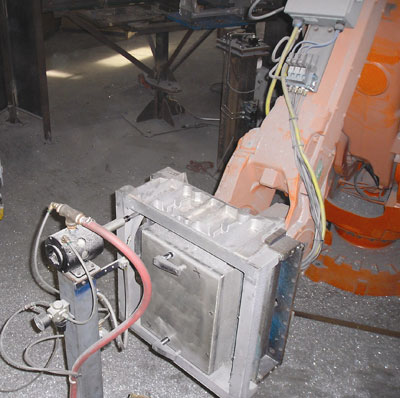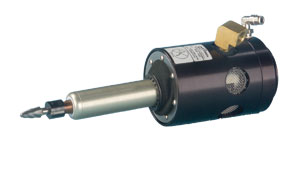December 2007 Edition
the finish line
Aluminum caster in NY finds flexibility in deburring solution
For Tom Wittmeyer, flexibility translates into production success.
"Flashing on die cast parts must be removed for operational, safety, and aesthetic reasons, but how this chore is completed has always come under considerable scrutiny by manufacturing engineers and, more important, Occupational Safety and Health Administration (OSHA) regulators," says Wittmeyer, process technician for TPi ARCADE Inc., Arcade, NY. "With the new, patented Flexdeburr RC-660, we have cleared the hurdle, cutting the deburring time in half and minimizing employee involvement. The automated tool allows us to robotically remove the flashing quickly and efficiently while virtually eliminating the operator's manual deburring and exposure to casting dust."
 When the aluminum casting comes out of the V-process, there are minor flashings that need to be removed. Harmony Castings LLC/TPi ARCADE uses ATI's Flexdeburr model RC-660 mounted in a stationary position and a robot to maneuver the part for deburring.
When the aluminum casting comes out of the V-process, there are minor flashings that need to be removed. Harmony Castings LLC/TPi ARCADE uses ATI's Flexdeburr model RC-660 mounted in a stationary position and a robot to maneuver the part for deburring.
The Flexdeburr RC-660, provided by ATI Industrial Automation, Apex, NC, gets high marks from Wittmeyer. "We have always looked for ways to implement robots to perform these routine and repetitive deburring tasks," he says. "However, we were somewhat restricted when programming the robot. Typically, robotic programming moves the deburring tool along a path defined by discrete points, and that path may not exactly coincide with the shape or contour of the surface to be deburred due to variations in the part itself or to differences between the part edge and the exact path the robot has interpolated.
"Implementing the Flexdeburr has solved that problem. The patented flexible deburring tool with inherent compliance utilizes a unique 'pivoting' motor and spindle arrangement that provides radial compliance that accommodates differences between the part edge and the actual tool path. The tool is designed to follow the part profile accommodating surface variations."
Reducing operations
Harmony Castings LLC/TPi ARCADE Inc. provides a multitude of casting services specializing in aluminum V-process manufacturing. Its manufacturing experts operate a wide variety of state-of-the-art, computer-controlled equipment to produce castings with finer finishes and tighter, more consistent tolerances. The V-process provides quick turnaround, high-quality castings ideally suited for prototyping and low-volume applications.
Some of the advantages of the V-process are zero-degree draft, which reduces weight and minimizes post-cast machining; thin-wall thicknesses of 0.125" over large areas and 0.09" in small areas; tight tolerances as much as twice as accurate as sand casting; unlimited pattern life lasting as long as the part's life; 150rms finish as compared to 250-550 for sand cast and 200-500 for permanent mold, and excellent molding integrity maintaining repeatability of all casting dimensions. Some of the parts produced for TPi customers include engine cases, primary covers, and tranny covers for Harley Davidson; alternator housings for Delphi Automotive; Snomobile drive covers for Polaris; engine oil pans for John Deere; and more.
"When the aluminum casting comes out of the V-process," Wittmeyer explains, "there are minor flashings that need to be removed. We use ATI's Flexdeburr model RC-660 mounted in a stationary position and a robot to maneuver the part for deburring. We started running the V-process in 1979, and all of the deburring operations were done manually until we implemented the Flexdeburr a few years ago. Our first installation of Flexdeburr resulted in a 90-percent reduction in deburring operations and an overall bench time reduction of 60 percent. Also, the reduced deburring time significantly lowers the employee's exposure to aluminum dust and other contaminants. This initial success has convinced us to look at other applications that can benefit from robotic finishing operations."
Solving a problem
Problematical burrs, residual material on parting lines, and flashing on die-cast parts must be removed for operational, safety, and aesthetic reasons. Traditionally, manual deburring operations relied on hand-held tools, but they led to several health and safety problems, such as carpal tunnel syndrome and "white fingers" (permanent numbness) when workers were subjected to constant vibrations, high-contact forces, and the required contorted positions characteristic of hand-held deburring tools. Metal, fiberglass, and other hazardous particles introduced into the workers' environment also posed health risks. In addition, the tedious, manual deburring task often resulted in inconsistent quality of the finished part.
 Flexdeburr is a patented, compliant deburring tool that satisfies nearly 100 percent of all robotic and automated deburring applications. The deburring tool has a unique "pivoting" motor and spindle arrangement that provides the deburring tip's radial compliance to perform consistently on irregular part profiles.
Flexdeburr is a patented, compliant deburring tool that satisfies nearly 100 percent of all robotic and automated deburring applications. The deburring tool has a unique "pivoting" motor and spindle arrangement that provides the deburring tip's radial compliance to perform consistently on irregular part profiles.
Many manufacturers have replaced their unpleasant and undesirable manual deburring processes with a sufficiently accurate automated alternative – robotic deburring. Robotic deburring and chamfering has typically been difficult to perform with the required degree of quality. The complexity of the part and the robot's limitation to generate a path exactly equivalent to the part edge make it difficult for the deburring operations to meet overall quality goals. Furthermore, the programming of robot movements is dependent on the complexity of the part, and complex parts require significant programming time to achieve acceptable robot paths.
The Flexdeburr is a robust, high-speed, air-turbine-driven tool for deburring aluminum, plastic, steel, and other materials, even in tough-to-reach places. While spinning at high speeds, the lightweight, rotary tool has radial compliance supported by air pressure applied to the shaft allowing the tool to perform consistently on irregular part patterns. The "pivoting" motor and spindle arrangement provides up to +/-0.31 (8mm) of radial compliance and maintains a constant deburring force.
The deburring tool has a rigid outer housing and an internal motor/spindle assembly that provides the compliance. The pneumatic spindle is supported by a pivot bearing secured to the tool's rear housing. This allows the spindle and cutting file to articulate freely and follow the part profile independent of the housing. The "compliance field" is created by a circular array of small pistons at the front of the tool housing, thus allowing free spindle motion radially in any direction (360deg) around the tool.
The Flexdeburr provides high stiffness from its pneumatically adjustable compliance force. This feature minimizes chattering, a common problem with robotic deburring. Deburring can be as fast as 1 to 3 in/sec (2.54 to 7.62 cm/sec) on hard materials; 3 to 12 in/sec (7.62 to 30.5 cm/sec) on soft materials.
The pneumatically driven tool has one air line to spin the cutting file, and a second air line to apply force radially to the motor/spindle assembly. Regulated air pressure on the pivoting spindle provides the constant force needed to produce a good quality finish. The tool is extremely light allowing it to hug the workpiece edge at a constant force even as the robot moves as fast as 12ips along the part profile. Additionally, the long, thin envelope of the "working" end of Flexdeburr allows deburring in tight, deep, and generally hard-to-reach places.
Easier programming
The inherent compliance at the deburring tip saves robot programming time. Programmers can program fewer path points since the tool compliance will accommodate deviations between the robot path and the part profile. The robot path does not have to precisely follow the part edge. Programming savings are multiplied in applications where multiple passes are necessary in order to achieve a desired finish.
Programming the robot path is easily achieved by temporarily mounting a dowel pin the same diameter as the desired cutting tool in the spindle. The robot is then moved to a point where the dowel touches the edge of a finished workpiece and the point is recorded. This is repeated at intervals along the part. A small tool offset is then programmed into the robot controller to account for part profile variations.
Tool details
Flexdeburr is a patented, compliant deburring tool that satisfies nearly 100 percent of all robotic and automated deburring applications. The deburring tool has a unique "pivoting" motor and spindle arrangement that provides the deburring tip's radial compliance to perform consistently on irregular part profiles.
The Flexdeburr, mounted to a robot or CNC machine, has a quiet air turbine motor that requires clean, dry, filtered, non-lubricated air that can be directly vented into the workplace. The deburring tool uses two air connections; one at 90psi to spin the cutting file, and a second variable supply at up to 60psi to apply the compliance force.
The motor's internal governor maintains high speeds up to 65,000rpm depending on the Flexdeburr model. Adjusting the compliance air pressure between 5 and 60psi sets the compliance force between 0.7 – 9.5lb (3.1 to 43.2N) depending on the Flexdeburr model. The tool uses standard tungsten-carbide industrial bits, which allow for adaptation to changing assembly lines and part requirements. The bits can be easily changed from one operation to the next.
ATI Industrial Automation, www.rsleads.com/712tp-171
How V-process really works
First, a thin plastic film is heated and placed over a pattern. A vacuum tightly draws the film over the pattern, which is then surrounded by a flask. The flask is then filled with dry, unbonded, extremely fine sand. The "mold" is vibrated so that the sand tightly packs around the pattern. After a second sheet of film is placed on the flask, a vacuum draws out the air, and the completed mold is then stripped from the pattern.
Each half of the mold is made in a similar fashion. Then aluminum is poured directly from the furnace into the closed halves. The mold is held under vacuum to retain its shape. After the mold cools, the vacuum is released and the sand and completed castings fall free. Simple in concept and far reaching in impact, V-process produces quick turn-around, high-value castings.
What do you think?
Will the information in this article increase efficiency or
save time, money, or effort? Let us know by e-mail from our
website at www.ToolingandProduction.com or e-mail the editor at
dseeds@nelsonpub.com.